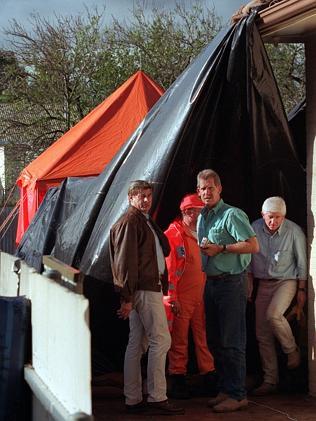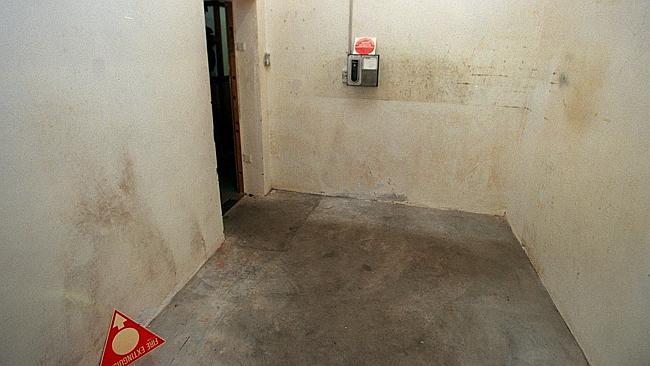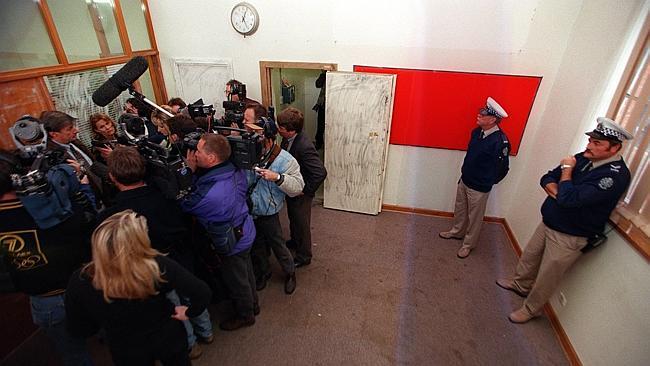Crime Week book extract: Snowtown: The Bodies in Barrels Murders, by Jeremy Pudney
CRIME WEEK PART 2: The bodies in the barrels murderers plumbed unspeakable depths of depravity. This was the moment police cracked the case.
SERIAL killer John Bunting was the mastermind of the unspeakable bodies in the barrels murders. This extract from Jeremy Pudney's book Snowtown revisits the moment police made the crucial breakthrough.
***
THERE is something alluring about the city of Adelaide. Few other cities in the world possess such a unique and charming mix of handsome historic buildings, wide streets, cosmopolitan cafés, and an abundance of beautiful parks and gardens. The air is clean, the lifestyle enjoyable and the people friendly. It's even safe to walk the streets at night. At least for the most part.
Adelaide's central business district has no serious skyscrapers to speak of, and covers what's lovingly called 'the square mile'. Beyond it the city's suburbs sprawl out in every direction, hemmed in by the picturesque Adelaide Hills to the east and a spectacular, pristine coastline to the west.
National Highway One cuts a swathe through Adelaide's northern suburbs and, beyond the urban sprawl, continues further north through barren, lonely country. As its journey continues towards South Australia's wheat belt, known as the Mid North, there is little more than salt-encrusted lands to one side of the highway and sun-scorched paddocks to the other.
Along the highway, 150 kilometres from Adelaide, is the small hamlet of Snowtown. It is a town nestled in the heart of a farming district noted for its quality stock breeding, fat lambs, wool and wheat crops. Settlers had come to the region in the 1840s seeking pastures for their flocks, and settled the town in 1867.
In the past few decades Snowtown has become, like many settlements in the Australian bush, a town in decay.
Economically times are tough and, while the population is just over 500, it tends to fluctuate as local young people leave to look for work or, simply, a better life. Others trickle in from Adelaide, lured by cheap housing and the rural lifestyle.
Snowtown's appearance is evidence of a boom time past: its wide main street is virtually deserted during the day and the town is dissected by a rail line on which trains that used to stop now barely slow as they pass.

Thursday, 20 May 1999, was an unseasonably warm day and Detectives Greg Stone and Steve McCoy hardly noticed the 'Welcome to Snowtown' sign as their unmarked police car cruised into town.
Their minds were on a job that for the past six months had led the pair on the trail of a group they now suspected were serial killers. Five people had vanished in four years; all were presumed murdered and cash had been siphoned from some of their bank accounts. There were at least three suspects, but no bodies had been found.
CRIME WEEK PART 1: The crimes that horrified South Australia
Detectives at the South Australia Police Major Crime Branch had been on the case for almost two years.
Investigations were well advanced and the evidence was mounting. A crucial piece in the puzzle, however, had not been found. Six months ago, just after a woman named Elizabeth Haydon had vanished, a witness reported seeing an old Toyota four-wheel drive parked outside one of the suspects' houses in Adelaide's northern suburbs.
Late one afternoon, the witness noticed a man loading plastic garbage bags into the vehicle. She described the back of the vehicle as being stacked from the 'floor to the roof ', saying, 'The man needed to push and force the bags into the rear of the Land Cruiser.'
By the time police learned of this suspicious cargo, the four-wheel drive had vanished.
Detectives Stone and McCoy arrived at the Snowtown police station at 11.30am and within minutes a team of officers had gathered inside. With them were Major Crime detectives Jane Dickinson and Mark Wilson, local investigator Rick Day, Senior Constable Ian Young, and three crime scene examiners: Gordon Drage, Andrew Bosley and Bronwyn Marsh. Their assignment, they were told, was to search a house at 25 Railway Terrace, Snowtown. They were to look carefully for anything that might be linked to the five missing persons; in particular, property and bank documents.
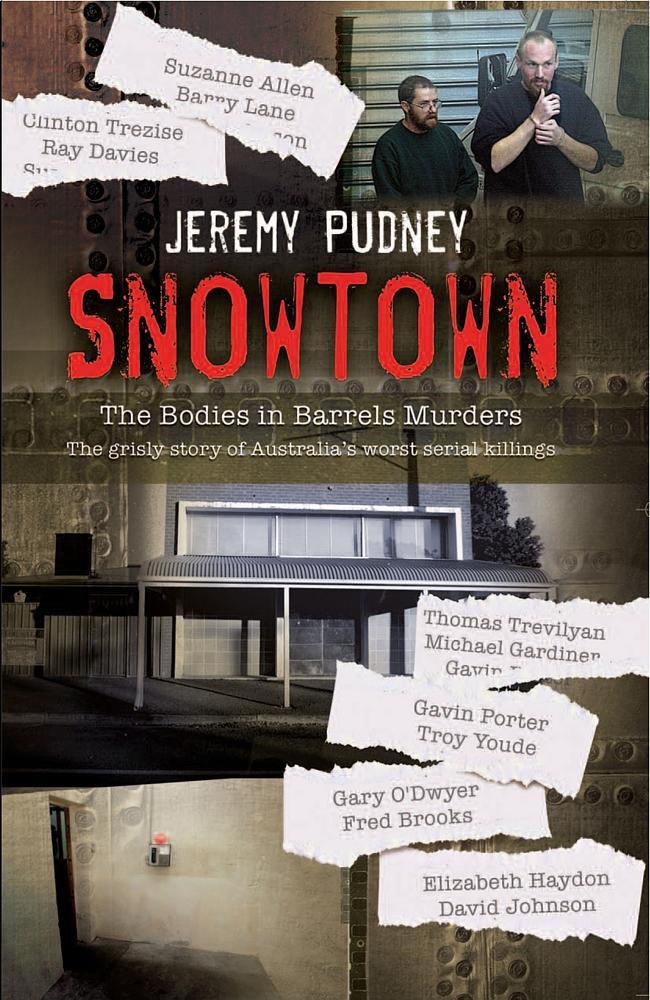
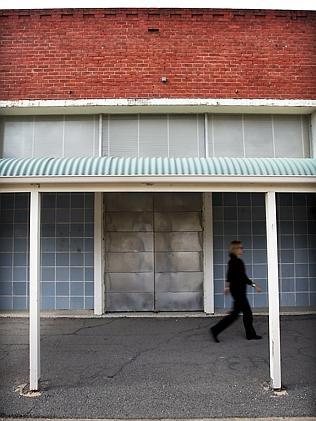
Most importantly, they were to examine and seize a vehicle in the driveway of the house. It was the Toyota Land Cruiser police had been hunting, which had been spotted there four days earlier.
The first thing Simon Jones noticed was the line of cars pulling up outside his house. They included the local policeman's wagon, followed by a tilt-tray truck. Next came the knock at the door; the detective who spoke first and flipped open his wallet to display his police badge.
'I'm Detective Senior Constable Steve McCoy.' He introduced the other officers. 'We've been investigating the disappearance of a woman named Elizabeth Haydon and we believe that a four-wheel drive may have been or was involved in that disappearance. We need to speak to you about the four-wheel drive in your driveway.'
McCoy showed Jones a search warrant and explained that his home would be searched and the vehicle seized.
The detective then led Jones to a police car out the front, where he would be interviewed.
As some of the officers began scouring the inside of Jones's home, filming their search with a video camera, Detective Stone made his way to the four-wheel drive. His eyes pored over the vehicle, which was mostly empty. He noticed that the registration plates had been removed and three windows had been left down.
Sitting in the police car, McCoy began questioning Jones about the four-wheel drive. Confused and a little frightened, Jones explained that the vehicle was not his but had been towed to his house by two friends. The friends' names were recognised instantly by McCoy - they were two of the suspects.
Inside the broken-down four-wheel drive, Jones's friends had apparently stored several large black plastic barrels.

They had emitted such a foul odour that his neighbours had complained.
'Where are the barrels now?'
As McCoy asked the question, Jones turned and gestured.
'They're over in the bank.'
McCoy stopped the interview, got out of the car and approached his colleagues.
'I think we've found the bodies.'
It was precisely 1.12pm when Detectives McCoy and Stone, along with officers Drage, Marsh and Day, arrived at the old bank. It was a plain red-brick building, nothing much to look at except for the imposing steel front doors, which had been closed by bank staff for the last time some four years earlier.
The police passed through a gate and approached the bank's side door. Simon Jones had given them a key - Jones's friends had leased the bank and left the key with him. In fact, he said, they'd even allowed him to store equipment from his electronics business inside the building.

Detective Day opened the side door and the officers moved in; Drage was first through the door and was using a video camera to record their every move.
Just inside was a kitchen area, and a door to the right leading to the bank proper. The bank counter and much of the customer area were stacked with cardboard boxes, each packed with computer parts, other electronics and an assortment of junk. Televisions and computer monitors in various states of repair were scattered around the floor.
Drage noticed a plastic shopping bag hanging from a door near the counter, filled with rubbish including a shopping docket. The docket detailed the purchase of air fresheners, rubber gloves and garbage bags. An air freshener was operating from a power point in the room, and a brief search of cupboards at the back of the counter uncovered several unused garbage bags.
The officers then turned their attention to the large, cream-coloured vault door. It was locked. Close examination of the door revealed the presence of a fingerprint in the top left-hand corner and Drage dusted the print with black powder, highlighting its swirling outline. The fingerprint needed to be photographed, so Drage headed back to Simon Jones's house to collect his other camera.
While there, the officer mentioned to one of his colleagues that the vault door was locked. No problem, Simon Jones told him. He knew how to open it.
As he led Drage to a large coil of galvanised fencing wire, Jones explained that the tumbler lock on the vault door didn't work and the door could be opened with a piece of wire. Jones cut off a length of wire and used a pair of pliers to make a small bend at one end and a larger turn at the other.
Drage returned to the bank and apprehensively pushed the wire into the lock. Crouched at the door, it took him only a few seconds of manipulation before he could feel that a tumbler inside the lock was moving. A little pressure and the vault door's chrome handle shifted to the unlocked position.
At 2.24pm Drage pressed the record button on the police video camera, its lens pointed towards the vault door. Detective Stone, wearing surgical gloves so as not to contaminate vital forensic evidence, reached for the handle and the heavy door swung open.

Black plastic sheeting covered the entrance, with clear adhesive tape securing it to the inside of the doorframe. A long vertical slit had been cut down the centre of the sheeting, obviously to allow access to the vault, and this too had been sealed with tape.
In the recess between the vault door and the plastic the officers noticed a wallet, a roll of packing tape, two keys and a book of lined writing paper.
As Stone peeled back the single strip of tape from the top - breaking the seal - he recoiled at the pungent smell emanating from the vault. There was no mistaking the stench of rotting remains.
Stone prised the plastic apart and, clasping his police issue torch, quickly scanned the inside of the vault. He forced the plastic further apart and took a step inside, followed by Drage, his camera still rolling.
The two officers had stepped into a place that had been the scene of unspeakable acts. It was dark, the stench overpowering, and they had yet to fully comprehend the gravity of their discovery. To their right were six large plastic barrels, each black and sealed with a screw-top lid.
They may not have been able to see inside, but neither Stone nor Drage doubted that each of these barrels contained human remains.
The barrels stood on two large pieces of black plastic positioned as drop sheets. On top of one barrel was a sinister sign: a pair of silver handcuffs and, next to them, a black-handled knife. On top of another barrel were two more black-handled knives and a pair of green rubber gloves.
To the officers' left, against the vault's northern wall, was a pale green lounge chair on which sat a white plastic tray containing seven more knives.

Alongside were two boxes of disposable gloves, a wooden-handled saw and what looked like a belt. In the back left corner of the small room was another lounge chair with three white plastic bottles, each bearing a label which read 'Hydrochloric Acid'. Scanning the inside of the vault, the officers could make out an array of other items - a can of air freshener, a pair of sandshoes
and a scattering of garbage bags, some of them full.
Outside the bank Steve McCoy made a telephone call to the Major Crime office in Adelaide. He reported that human bodies had been found, but exactly how many - and who they were - was unclear. McCoy then returned to the bank and gave the order to clear the building. By 2.30pm the side door was closed and a guard stationed outside.
The cavalry was coming.
***
Extract from Snowtown: The Bodies in Barrels Murders, Jeremy Pudney. Harper Collins. RRP $29.95, e-book $12.99.
For more information or to order a copy, click here. For an e-book version, click here
Jeremy Pudney was a police reporter at The Advertiser when news of the Snowtown murders first broke. He is now the News Director at Ten Adelaide.
